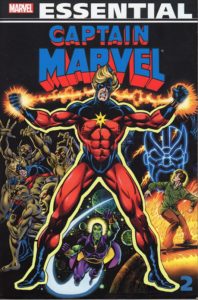Comic Book Review: Essential Captain Marvel Vol. 2 by various creators.
Back in 1967, Marvel Comics became aware that the name “Captain Marvel” for a superhero had fallen out of trademark status. It was too good a name for Marvel to pass up, so Stan Lee quickly came up with a character to appear in Marvel Super-Heroes #12, who then appeared in his own series. Captain Mar-Vell was a representative of the alien Kree Empire, sent to spy on the Earth for potential conquest. He was chosen for the job because of being of the oppressed minority “Pink Kree” who happened to look like Caucasian humans, as opposed to the majority “Blue Kree.” (This allowed Marvel Comics to play him as an underdog who faced prejudice, while still having a “white” character as the hero.)
Mar-Vell assumed the identity of recently deceased scientist Walter Lawson and began working at Cape Canaveral in Florida, the better to spy on the space program. When danger threatened his co-workers, Mar-Vell put on his Kree uniform (with its face-hiding helmet), and due to accidentally revealing his name became known as the superhero Captain Marvel. Unfortunately, Mar-Vell’s commanding officer Colonel Yon-Rogg wanted to steal his subordinate’s girlfriend, Nurse Una, and proceeded to try to get Captain Marvel killed.
Several issues in, Mar-Vell’s powers were reworked, and he was bonded with perennial sidekick Rick Jones–only one of them could be in the positive universe at a time, which the other floated around in the Negative Zone, swapping places with power-enhancing bracelets called Nega-Bands. (And yes, this was a riff on the original Captain Marvel’s relationship with Billy Batson.) Sales were never particularly good, and the series went on hiatus for several years while the character guest-starred in other heroes’ books.
Which brings us to the volume at hand. Issue #22 starts with Captain Marvel apparently dead, having given up his lifeforce to save Rick Jones at the end of the Kree-Skrull war. But no, he was just “hiding” and a mad science treatment allows Mar-Vell to return to trading places with Rick. The first few issues are standard superhero stuff, but then comes the Starlin run. Jim Starlin was new to Marvel Comics at the time, but had big ideas for a cosmic plotline involving several characters he’d designed, and he convinced Marvel to let him anchor it with Captain Marvel.
This involved Thanos, one of a race of godlike beings that inhabited Titan, a moon of Saturn. In love with Death (literally), he rejected the peaceful ways of his people to become a conqueror, gathering an army of outcasts and criminals from across the galaxy. Along the way, he inspired the creation of Drax the Destroyer, a golem-like creature whose sole purpose was killing Thanos. (This version was very different from the one most of you will have seen in the Guardians of the Galaxy movie, among other things being a formidable telepath.)
Thanos’ plans to conquer Earth accelerate when he learns that Rick Jones (unknown to himself) knows the location of the Cosmic Cube, a device that can reshape reality to the holder’s whim. The mad titan plans to use it to elevate himself to true godhood, making him omnipotent. While Captain Marvel and his allies manage to defeat some of Thanos’ minions and slow down his plans a bit, it is not until Mar-Vell is granted “cosmic awareness” by a being called Eon that he is finally able to save the day, resulting in Thanos’ first death.
The high-stakes action and some trippy visuals impressed the heck out of 12-year-old me, and a lot of other kids, and Jim Starlin became a favorite creator. After the end of the Thanos Saga, Starlin stayed on only long enough for a transitional issue to Steve Englehart’s run. #34 had Mar-Vell go up against a C-list villain named Nitro, whose power was exploding himself. At the end of the issue, Mar-Vell was exposed to experimental nerve gas, (Much later it would turn out he had developed inoperable cancer from this exposure, resulting in the classic story The Death of Captain Marvel.)
Nitro turned out to be a minion of the Lunatic Legion, Blue Kree purists headquartered on Earth’s Moon. They in turn turned out to be pawns of the Kree Supreme Intelligence, who had been orchestrating events for years to turn Rick Jones into a jump-start for Kree evolution (this is not how evolution works; just roll with it.) This volume ends with Mar-Vell and Rick defeating the Supreme Intelligence’s plan, but not without cost.
There are a couple of appearances by Carol Danvers (who’d been chief of security for Cape Canaveral during the early issues of the series) who has been demoted due to the events surrounding Lawson. She doesn’t get to show off her competence, alas. Things would look up for her a couple years later when she became the superhero Ms. Marvel, and Carol is now the Marvel Universe’s Captain Marvel.
Englehart’s run was also pretty good, but not up to the level of Starlin’s; some good art by Al Milgrom helps.
Trivia note: A black singer says that she wants to be “Tina Turner–without Ike” two years before Ike’s abuse of Tina became public knowledge.
In addition to general superheroic violence, there’s the “fantastic racism” previously mentioned. In addition to the skin color issues of the Kree, the Kree and their long-time enemies the shape-shifting Skrulls regularly hurl slurs at each other. (Even Mar-Vell himself indulges in this before gaining cosmic awareness.) There’s also an issue where Rick takes a hallucinogenic drug a friend gave him without consideration of what that might do to his mental link with Mar-Vell.
The art suffers some from the lack of color (Starlin did his own colors, which made his issues really pop.)
Recommended to Captain Marvel fans on a budget and Starlin fans in particular; check your lending library.

